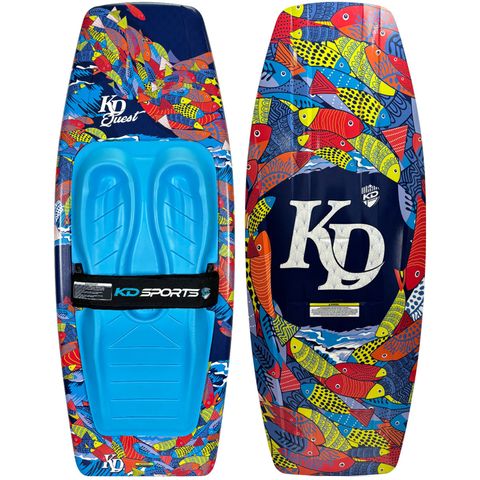Kneeboards
Kneeboarding is a fun and approachable tow sport and is often used as a steppingstone into more difficult water sports such as skiing or wakeboarding. Kneeboards appeal to both kids and adults and are available in various constructions and a range of price points. In this article we’ll walk you through what makes them different and how to know which kneeboard to choose when starting out or when upgrading an old board!
ABILITY LEVELS & CONSTRUCTIONS:
- BEGGINER (PLASTIC CONSTRUCTION): Starting new kneeboarders out on a stable and forgiving board is important and will aid fast progression. Beginner kneeboards are made of a tough, durable plastic construction that is extremely buoyant. Buoyancy results in a board that will surface quickly and remain stable and balanced even at low speeds. Beginner/Plastic kneeboards always include a built in or pop-up style front tow hook designed to lightly hold the handle when moving from the laying down position to the knees. Plastic kneeboards feature a gentle, round rail, not only allowing smooth turns but also reducing the chance of a rider taking a nasty head knock while riding doubles. As the construction of plastic kneeboards is almost always the same, the price difference between beginner kneeboards is determined by the quality of additional components such as the foam kneepad, the kneeboard strap and the presence of drop-down fins only found on a few models. Beginner/plastic kneeboards are the best choice for young kids, adults new to the sport and generally a great option to have in the boat for friends and family.
- INTERMEDIATE (FIBRELGASS CONSTRUCTION): Intermediate kneeboards move from a plastic to compression moulded fibreglass construction much like a wakeboard or water ski. The result is a board that is significantly thinner with a sharp rail and far less buoyancy. While the sharp rail and reduced buoyancy improves manoeuvrability and edge hold, it comes at the cost of balance and stability. Most intermediate/fibreglass kneeboards include inserts to easily add a front tow hook to aid starts, however we generally suggest riders that can use a fibreglass kneeboard shouldn’t need one. Intermediate kneeboards are best for riders that are confident on the water and aim to progress their skills with surface spins and wake jumps.
- ADVANCED: Advanced kneeboards are designed to be lightweight, responsible, and high-performance. While sharing most design cues with intermediate kneeboards, advanced kneeboards will additionally include materials such as carbon fibre for added response and pop off the wake. Advanced kneeboards feature top quality kneepads and double locking straps to keep you locked in. Advanced kneeboards are best for high-end riders aiming to spin and flip wake to wake.
PROFILES:
- CONTINIOUS ROCKER: The profile of a kneeboard changes its personality and riding style. The profile of a kneeboard is defined as the boards shape when viewed on its side from tip to tail. A ‘continuous’ rocker kneeboard features a smooth, consistent arc with no flat spot interruptions. Continuous rocker kneeboards carry more top-water speed, feature smooth, consistent take-offs and softer landings.
- 3-STAGE ROCKER: Continuous rockers arch nemesis, ‘3-Stage’ rockers feature a flat spot under your knees. This flat spot interrupts the flow of water but instead creates a solid platform for the kneeboard to ‘pop’ off when releasing from the top of a wake. 3-stage kneeboards often feel ‘loser’ on the water and may not carry as much top-water speed as continuous boards, however they are more likely to give more punch and go higher off a wake.
- 2-STAGE ROCKER: Much the same as 3-stage rocker kneeboards, 2-stage rockers are fast across the water with a significant amount of pop when attacking the wake both forwards, and backwards.
SIZE GUIDE:
Whilst kneeboards are ‘one size fits all’, not every kneeboard suits every weight of rider. The top-down profile affects a kneeboards overall surface area, with narrow boards catering for kids and light adults, and wide boards catering for most adults. A simple tell is to compare the kneeboards tail width in relation to its forebody. A board with a narrow tail will roll from edge to edge effortlessly but provide less pop off the wake. A board with a wide tail will be more difficult to roll from edge to edge (especially the case for kids) however provides maximum pop off the wake.



